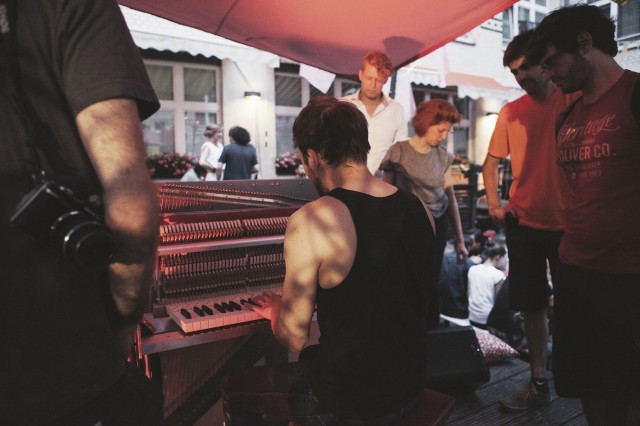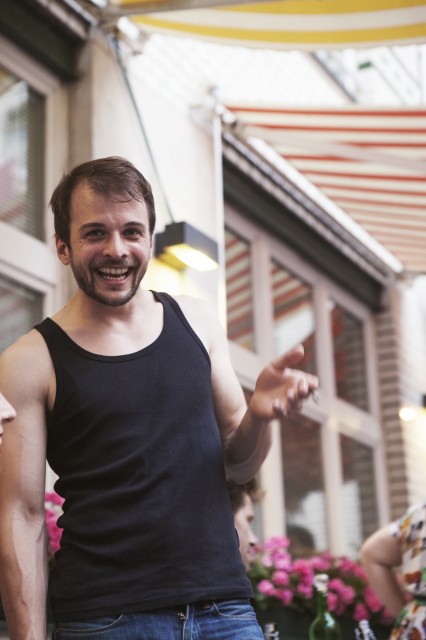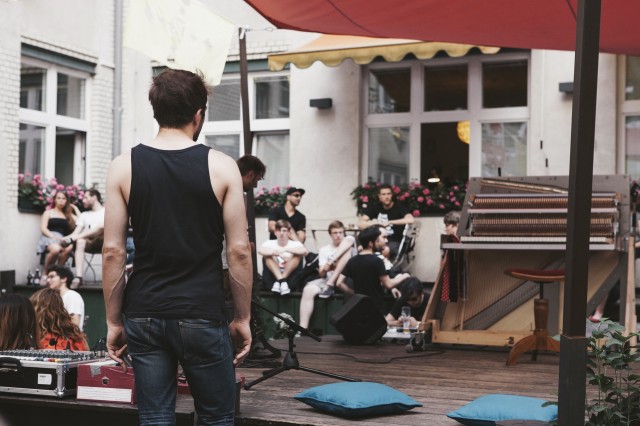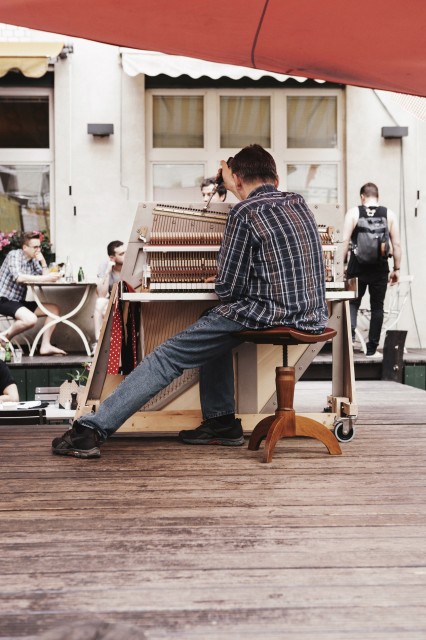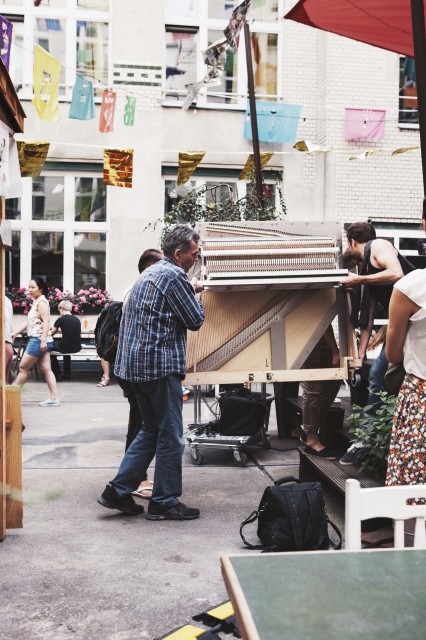Now this is a revolutionary etude.
There’s no question the acoustic grand is an engineering wonder, a musical instrument with literal tons of string tension producing unparalleled sound. But it’s a 19th Century technological marvel. Innovations, apart from subtle variations, have been largely frozen since the likes of the Steinway & Sons Model D-274. The Model D is a beauty; the question is, what have builders been doing with the 155 years since it was introduced?
Builder David Klavins is a master instrument maker re-imagining the piano for our century. And he isn’t afraid to go to extremes to do it. His 1987 Model 370 was so named because it’s 370 cm – over 12 feet – tall. It’s an upright piano so huge, there’s a flight of stairs attached to it to give the pianist access. (Native Instruments sampled the 370i as The Giant, in case you don’t have a two-story-high living room.)
The Klavins UC – Una Corda – is more down to earth. With one string per key, rather than the usual two or three, it’s far lighter and easier to build. Those strings are paired with a thinner soundboard, shedding still more weight. It omits the bulky bridges necessary on a conventional grand, exposing more sound. The result is an instrument that is phenomenally more mobile; the entire instrument weighs under 100 kg (just over 200 lbs), even with its complete action installed.
The first UC is a special commission for pianist Nils Frahm, the Hamburg-born composer and musician. Nils invited guests into the courtyard of the Michelberger Hotel in his home base of Berlin in order to give the UC its first public debut. David Klavins came along for the event, quick to give anyone an earful of philosophy about how piano innovation can again move forward.
We got hands-on (literally) with this new instrument, and got a chance to talk to its maker about how it’s different, and why it sounds the way it does.

Crowds gather in the sweltering summer to cool off with exquisite music from Nils Frahm – and their fellow guests. Photo: CDM.
To really appreciate the UC, you have to play it in person. First, the una corda name is a bit of a misnomer, if you’re accustomed to the meaning as it applies to the pedal of the same name. That pedal shifts the hammers, but still strikes as many as two strings, and the resulting sound can be a bit muted or dull, because you’re still using the same thicker soundboard.
The klavins UC is anything but muted. That thinner soundboard, unobstructed by the bulky metal and wood structures in a normal piano, feels almost like it was borrowed from a guitar. The resulting sound is delicate and intimate. It sounds like a piano, but in a way that seems almost impossible; it’s bright and resonant the way the sweet spot of a concert grand might be, but across every register, and emanating out of tiny instrument. The sound is whisper-soft: even with amplification, you could hear the soft rustling of the metal-foil flags suspended above the courtyard as they blew in the breeze. But it’s also clear and rich with color.
Then there’s the action, which is what got me hooked. It’s feather-light, confident but unbelievably quick. It feels like a small spinet piano, if that were tuned like a high-performance race car. It’s so easy to play, in fact, that it could fool almost anyone into believing you suddenly had virtuoso powers. I have to admit, I was a bit skeptical of the whole instrument. Then I sat down at it – and desperately wanted to roll it back home with me. (And, in fact, had no one notice, I could have. This is a piano one person can move.)
Nils Frahm’s pensive, gentle music was perfectly suited to the character of the instrument built for him. He also made use of a clever feature: because access to the strings is uninhibited, it’s possible to add preparations simply by attaching strips of fabric via velcro stands on either end of the soundboard.

Attaching a cloth preparation, via velcro – smart. Photo: CDM (erm, actually, someone I lent my camera to).
But this isn’t just a piano for Mr. Frahm. Klavins intends to put the instrument into production for the general public, with customizations possible. The pricing should be under 10,000€ – a bargain for a piano of this quality, let alone one custom built, and all thanks to the elegant design inside. And it’s not hard to see a market. The instrument is equally well suited to historical and new contemporary compositions, and it’s vastly easier to tune, move, and afford than more conventional acoustic pianos.
For a sense of the instrument, listen to David demonstrate its sound, followed by an impromptu recording of one of Nils’ performances. (The sound quality of the latter is poor, but you get the idea. The former I thought initially was some sort of experimental tuning, but I see from the description that it’s a sound test and the tuning system here is “not quite yet tuned.”)
Guests of the event were able to come play the instrument. In a moment that took the audience’s breath away, a skateboarding English tourist proved to have an angelic, otherworldly voice. (That tourist turned out to be musician Tom Adams.) Nils first acted as a human microphone stand, then joined in. In the oppressive summer heat, it was a magical moment: not a spine without chills, not a dry eye.
I grew up a piano player before all other things, from the time I was literally old enough to reach the keys. So I was thrilled to get to talk to David about his instrument for CDM. It’s a chance to meet the man who might be the first great new piano innovator in generations.
CDM: Let me just clarify: you’ve paired the single strings with a soundboard that is – half as thick as a conventional concert grand? Anything else that you should share about the construction?
David: The soundboard of the UC is on average half the thickness of a concert grand piano. An additional major difference is the cross-laminating of two layers of solid spruce at the UC, versus a single layer solid spruce soundboard at any conventional piano, including the Steinways. Plus, there’s no ribs on my soundboard, which makes it way more flexible, enables the soundboard to vibrate freely at all the various regions where the respective string vibrations are transferred via the bridge.
The strings themselves, do they differ from what you’d find on a similarly-sized upright or spinet?
Yes, the strings differ. I’ve chosen 3 different types of Stephen Paulello steel wire, versus one general type of wire that is applied to all industrial production pianos world wide. Stephen Paulello has developed steel wires of differing strength, which allows for choosing optimal types of steel to adjust the percentage of load of the strings, which again is one of the most important factors to achieve a balanced tonal character at the piano. You can find a general description of Stephen’s wires here:
http://www.stephenpaulello.com/en/cordes
Can you describe the way in which the string and soundboard interact? I was really surprised that this piano has some of the brightness of a grand piano, but with the sort of intimacy of a guitar and guitar resonance.
At the UC, the acoustic concept of design is a tension-less soundboard of high vibration ability that offers a maximum sensitivity to the strings, at the given frequencies that range from 55 to approximately 2100 [Hz]. For an optimal interaction of strings and soundboard, it is vital that the soundboard shows no excessive stiffening, which inevitably occurs at the traditional design of a piano soundboard, because of the ribs and crown, essentially, plus the 3-chord wiring. Once you will have a chance to analyze the UC sound character, you will notice much more similarities to a grand, than an upright piano, except the absolute loudness, for the reasons mentioned above.
The action itself was to me as impressive as the sound. You mentioned that you had introduced some innovation in the construction of this action, as well – how is it constructed?
The action design takes advantage of the fact that I use much lighter hammers, compared to any traditional piano. The mass of the piano hammer is a crucial factor directly relating to the potential speed of the hammer movement, in particular because its location at the farthest and of the moving lever – the hammer shank.
Because of the mass reduction at the hammer, which I achieve by thinner hammers and the materials in use (bamboo cores in particular), I have added weights to the back check, which fosters a precise control of touch, and significantly supports a fast let-off of the jacks. Altogether this concept achieves a more ‘grand-like’ feel of the action, including a repetition speed that is unmatched by regular upright action mechanisms.
What was the working relationship like with Nils Frahm? Was there specific feedback or input he provided?
Nils’ input throughout all stages of the designing process was as significant technically as it was inspiring by its very nature – his subtle, thorough attitude and approach to our project, paired with a deep understanding of how piano sound can be created and influenced was a major factor for me to finally carve out the details of the design. At all stages of the designing and building process we stayed in close contact, exchanging our thoughts, discussing the various options, finally finding agreement on all aspects of the design that were implemented. In my view, Nils’ input was vital for achieving the final results with the UC.
The tuning in the video sounds interesting. Are there other tunings you’ve found work well with the instrument? And tuning appears to be quite simple and quick, closer to what you’d do on a harpsichord than a piano, yes?
The UC should turn out to be the most appropriate modern piano to suit the acoustic visions of pianists who specialize in historical music compositions, in my view, because its sound potential (and design) accomplishes several aspects of significant importance on this field:
a) the una-corda-principle creates a pure tonal character, that (depending on the playing technique) resembles the early hammer pianos, harpsichord sounds, and something of a clavichord, at the same time offering the versatility of touch of a highly sophisticated modern action.
b) though the string scale is that of a modern piano, it is most easy to apply different historical tunings to the piano, as you suggest – it takes roughly 20 minutes for a fine-tuning of the UC.
Would adding pickups or other amplification be possible? Would it be desirable? I imagine it could open some possibilities, since the instrument is so quiet, but might also expand sonic possibilities.
Adding pickups and other means of sound amplification (or modulation) seems to me a logical option, adding to the versatility of the sound potential of the UC. It is possible very easily, and I believe Nils will definitely demonstrate a lot of such variations, in the course of time. Straight stringing in combination with the steel-frame without inner support bars offers a lot of space for all kind of additional ‘attachments’.
You’ve of course worked on a variety of instruments. Can you tell us how the UC fits in with other creations? Obviously, the Klavins Klavier Modell 370 (and 470i) is an opposite extreme.
The UC fits perfectly in my philosophy of piano sound design, which can be defined as: exploring and expanding acoustic piano sound to a maximum, be it the maximum range of dynamics, or the tonal colors, or other factors, like sustain, balance of registers, and last not least, the range of the keyboard. In my view, piano sound generally must be as versatile, as pleasant, inspiring to pianists, composers and listeners, as possible. To achieve all of the mentioned, we need to step outside the boundaries that have been imposed by the traditional piano industry.
What’s next for you – will you focus on the UC?
My intentions is to focus on the UC as much as possible, trying not to delay my next concert piano model, the 450i. For sure I find it most fascinating to explore the sound potential of a small size piano as well, especially thinking of how relevant it is for a multitude of creative artists who can’t afford a private concert hall, but are eager to find new means of musical expression. It is my very personal opinion that music can ‘save the world’, at least in a way, and if I can contribute to this perspective by building inspiring pianos, I feel like the luckiest man on Earth. 🙂
Your work now is really in acoustic technology. Would you ever consider incorporating electronics such as pickups, or is it simply a matter of acoustic technology offering enough to explore without it?
While my personal expertise is piano acoustics, I’m absolutely open to, and would welcome any way of a meaningful collaboration with experts on the field of electronics, if thy have ideas to offer how to increase the potential of the acoustic piano by combining it with the means of modern technology – definitely positive.
Photo Essay: Nils Takes to the Keys
Photos: Claudia Gödke.
More on the piano:
http://www.klavins-pianos.com/
A World First in Piano Building – The ‘klavins UC’ – Una Corda Piano
More on the pianist:
http://www.nilsfrahm.com/


